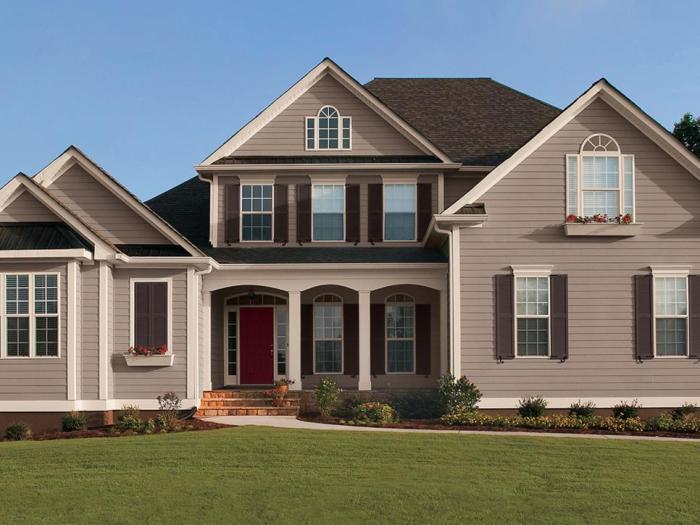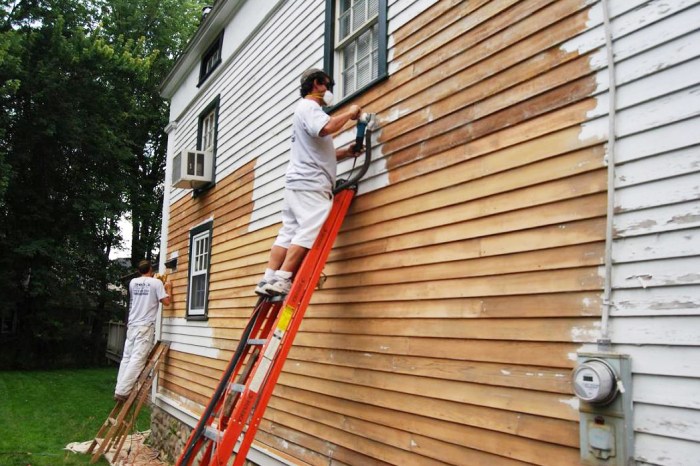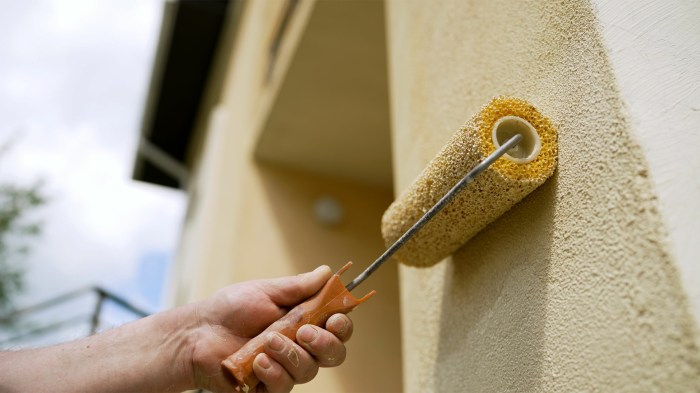Enhancing Your Home: The Ultimate Guide to Exterior Home Painting
Embark on a journey through the world of exterior home painting, where colors and creativity collide to transform your house into a stunning masterpiece. From protecting your home's value to boosting its curb appeal, discover the secrets to a successful exterior paint job.
As we delve deeper into the intricacies of paint types, preparation steps, and painting techniques, you'll uncover the key to achieving a flawless finish that will leave your neighbors in awe.
Importance of Exterior Home Painting

Exterior home painting plays a crucial role in maintaining a home's value and overall appearance. It not only enhances the curb appeal but also protects the house from various weather elements.
Protecting from Weather Elements
Exterior paint acts as a shield for your home, protecting it from harsh weather conditions such as rain, snow, sunlight, and wind. Without proper paint, the exterior surfaces are vulnerable to damage, leading to costly repairs in the long run.
Enhancing Curb Appeal and Aesthetics
Choosing the right color and finish for your exterior paint can completely transform the look of your home. A fresh coat of paint can make your house stand out in the neighborhood, increasing its curb appeal and overall aesthetics. It also gives your home a well-maintained and inviting appearance.
Types of Exterior Paint

When it comes to painting the exterior of your home, choosing the right type of paint is crucial for achieving a long-lasting and visually appealing finish. There are several types of exterior paint available in the market, each with its own unique characteristics and benefits.
Oil-Based vs. Latex-Based Paints
Oil-based paints are known for their durability and ability to create a smooth and glossy finish. They are ideal for high-traffic areas and surfaces that are exposed to harsh weather conditions. However, they tend to yellow over time and require solvents for clean-up.On the other hand, latex-based paints are water-based and offer easy clean-up with soap and water.
They are more flexible than oil-based paints, making them less prone to cracking and peeling. Latex paints are also more resistant to fading and mildew growth, making them a popular choice for exterior painting projects.
Benefits of Using Acrylic Paint
Acrylic paint is a type of latex paint that contains acrylic resins. It offers excellent adhesion, flexibility, and durability, making it an ideal choice for exterior surfaces. Acrylic paint is also resistant to fading, cracking, and blistering, ensuring a long-lasting finish for your home's exterior.
Additionally, acrylic paint dries quickly and emits fewer VOCs, making it an environmentally friendly option for exterior painting projects.
Preparing for Exterior Painting
When it comes to painting the exterior of your home, proper preparation is key to achieving a professional and long-lasting finish. Preparing the surface before painting ensures better adhesion, durability, and overall aesthetic appeal.
Cleaning the Surface
Before starting the painting process, it is crucial to clean the exterior surface thoroughly. Remove any dirt, dust, mildew, or other contaminants that could affect the paint's adhesion. Pressure washing or scrubbing with a mixture of water and detergent can help eliminate these impurities.
Sanding and Repairing
After cleaning, inspect the surface for any imperfections such as cracks, holes, or peeling paint. Sanding the surface smooth and repairing any damaged areas will ensure a seamless and uniform paint application. Use a high-quality filler to patch up any holes or cracks before proceeding with painting.
Priming the Surface
Priming the exterior surface is essential to create a uniform base for the paint to adhere to. Primer helps seal the surface, improves paint adhesion, and enhances color durability. Choose a primer that is suitable for the surface material and the type of paint you will be using.
Choosing the Right Tools and Equipment
Investing in the right tools and equipment is crucial for a successful exterior painting project. Quality brushes, rollers, sprayers, and other painting tools can make a significant difference in the final result. Ensure you have the necessary protective gear, such as gloves, goggles, and masks, to keep yourself safe during the painting process.
Exterior Painting Techniques
When it comes to exterior painting, using the right techniques is crucial to achieving a professional finish that will last for years to come. Here, we will discuss different techniques for applying paint to exterior surfaces, including cutting in, rolling paint on large areas, and achieving a smooth finish.
Cutting In
- Start by using a brush to carefully paint along the edges of the surface, such as where the walls meet the trim or corners.
- Hold the brush at a slight angle and use steady, even strokes to create clean lines.
- Take your time with this step to ensure precision and avoid getting paint on unwanted areas.
Rolling Paint on Large Areas
- Use a high-quality roller and extension pole to cover large exterior surfaces efficiently.
- Start by loading the roller with paint and then apply it in a zig-zag pattern to ensure even coverage.
- Work in small sections, overlapping each pass slightly to blend the paint seamlessly.
Achieving a Smooth Finish
- After cutting in and rolling the paint, use a technique called "feathering" to blend the brush and roller marks for a smooth finish.
- Work quickly and lightly drag a dry brush over the painted surface in long, smooth strokes to eliminate any visible lines.
- Pay attention to the direction of the brushstrokes to maintain a consistent finish across the entire exterior surface.
Epilogue

In conclusion, exterior home painting is not just about adding a fresh coat of paint. It's about preserving your investment, showcasing your style, and creating a welcoming facade that stands the test of time. So, grab your brushes and paint with confidence, knowing that you have the knowledge to make your home truly shine.
FAQ Overview
How often should I repaint the exterior of my home?
It's recommended to repaint every 5-10 years, but this can vary based on climate and paint quality.
Can I paint over existing exterior paint?
Yes, as long as the surface is properly prepped and primed to ensure adhesion.
Is it necessary to power wash the exterior before painting?
Yes, cleaning the surface is crucial to remove dirt, grime, and old paint for better paint adhesion.




